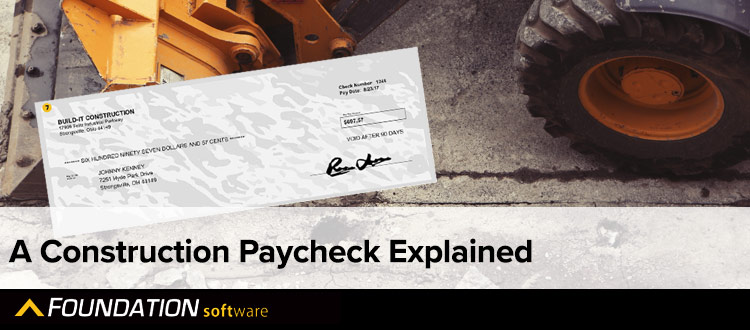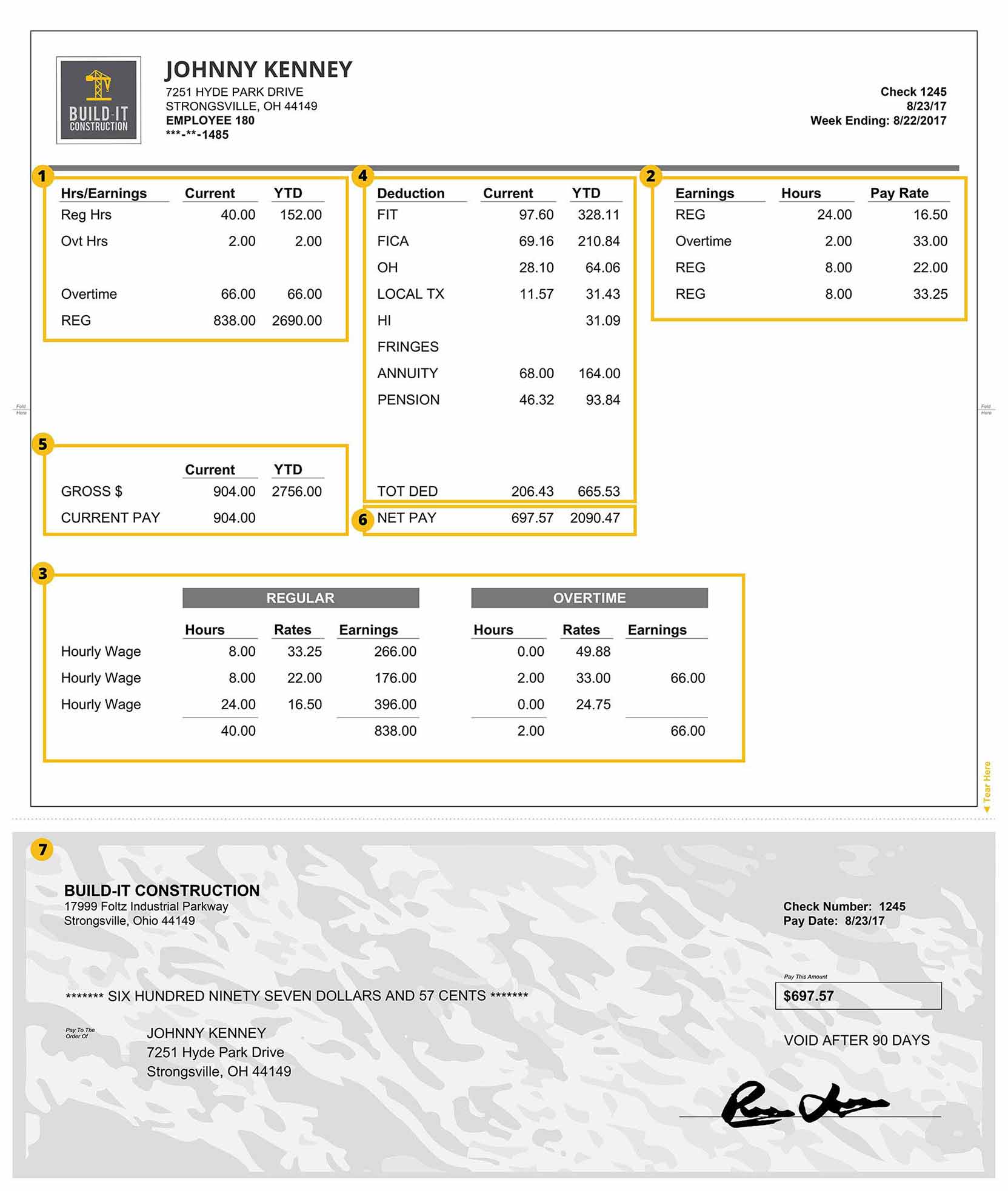
If you do construction payroll, you know that it’s not always simple. Whether you’re dealing with prevailing wage rates, union benefits, taxes for multiple states and localities, or even just overtime pay, there’s a lot that goes into calculating the amount your employee receives.

This can lead to questions from employees who wonder what all the seemingly cryptic codes on their pay stubs mean. The next time someone asks how the total was calculated, this example paycheck — calculated with FOUNDATION construction accounting software — may help.
Click on each section to learn more!

Accruals
This section is all about accruals. In this case, it summarizes the “regular” and “overtime” hours, because you can set up FOUNDATION to track when your hours cross the overhead threshold. This is where you’ll also find PTO and vacation accruals you’ve set up in the system. If you’re salaried, it’ll show those earnings instead of hours.
It also shows a year-to-date (“YTD”) total for each type. “Year-to-date” means starting Jan. 1 of the current year and going through the end of the pay period.
Earning Types
This section of your pay stub lists the various earning types on your timecard. In this example, there are only two used, but you’ll see “REG” several times. That’s because this employee has multiple pay rates depending on his trade, shift or jobsite — which you can see in Section 3 — all things his construction accounting software can sort out automatically with minimal data entry.
Wage Summary
The wage summary breaks out the regular and overtime hours into more detail so you can see the total earnings for each rate. Underneath, a totals line then gives you the sum of all regular and overtime hours along with their earnings.
Deductions
Deductions are amounts taken out of your gross pay. Many of these are taxes owed on your income that your employer withholds and sends to tax agencies on your behalf. But there may be other deductions on your pay stub as well. Let’s look at a few examples.
FIT (Federal Income Tax) is what most people think of when they think of income tax. It’s calculated based on your annual income, filing status and gross pay.
FICA (Federal Insurance Contributions Act) is commonly referred to as “Social Security” but also includes Medicare. The amount FICA withholds from your paycheck for Social Security is based on a fixed percentage of your earnings up to a certain cap. For Medicare, FICA also deducts a fixed percentage of your earnings, but there’s no cap.If you’ve worked in a jurisdiction that has its own local income taxes, they may also represent deductions. On this example paycheck, taxes have been withheld for Ohio and a local tax identified as “LOCAL TX.”
If you’ve worked in a jurisdiction that has its own local income taxes, they may also represent deductions. On this example paycheck, taxes have been withheld for Ohio and a local tax identified as “LOCAL TX.”
Some states may require “SDI,” (State Disability Insurance) or “TDI” (Temporary Disability Insurance) withholdings. These are taxes that your employer pays to the state on your behalf toward disability and unemployment insurance programs.Finally, other deductions may include 401(k) programs, flexible health care spending accounts, insurance premiums, fringes, annuities or pensions. Some of these may be “pre-tax” deductions made before taxes are calculated, which can reduce your tax amount.
Finally, other deductions may include 401(k) programs, flexible health care spending accounts, insurance premiums, fringes, annuities or pensions. Some of these may be “pre-tax” deductions made before taxes are calculated, which can reduce your tax amount.
If the abbreviation used for any deductions is unclear, ask your employer what it stands for so you can keep informed on where your earnings are going.
Gross Earnings
This section contains your gross earnings, the amount you earned before any deductions. It also contains any employer contributions and your gross taxable amount (here labeled as “FIT”), which is calculated by subtracting any pre-tax deductions from your gross pay.
Your federal tax rate — and your rate for any tax authority that recognizes your pre-tax deductions — is multiplied by this amount to determine current tax withholdings. Sometimes a tax authority will recognize one pre-tax deduction but not another.
Net Pay
“Net pay” is the part you probably care most about! It’s also called “take home pay” — the amount the paycheck is written for. Net pay is calculated by subtracting the total deductions in for the current period from your gross pay.
The Actual Check
The actual check or direct deposit slip indicates your net pay, the pay date, the check number, and the payee: you. If your paycheck is direct deposited to your bank through ACH, this section will often have “VOID” printed on it to prevent it being deposited as a check accidently.
Share Article
Keep on current news in the construction industry. Subscribe to free eNews!
Learn about our software more in depth with product overviews, demos, and much more!

Our ACA reporting & e-filing services include official 1094-C and 1095-C IRS reporting, optional e-filing (no applying for a TCC code required), mailing to your employees and experienced support to help you.

There are plenty of reasons to make FOUNDATION your choice for job cost accounting and construction management software — just ask our clients!

From job cost accounting software, to construction-specific payroll. Get an overview on your next all-in-one back-office solution.



